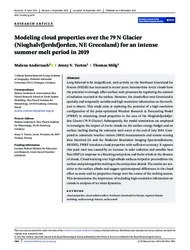Modeling cloud properties over the 79 N Glacier (Nioghalvfjerdsfjorden, NE Greenland) for an intense summer melt period in 2019
DOI: https://doi.org/10.1002/qj.4374
Persistent URL: http://resolver.sub.uni-goettingen.de/purl?gldocs-11858/10859
Persistent URL: http://resolver.sub.uni-goettingen.de/purl?gldocs-11858/10859
Supplement: https://doi.org/10.5065/EM0T-1D34, https://cds.climate.copernicus.eu/cdsapp/#!/search?type=dataset, https://ladsweb.modaps.eosdis.nasa.gov/search/
Andernach, Malena; Turton, Jenny V.; Mölg, Thomas, 2022: Modeling cloud properties over the 79 N Glacier (Nioghalvfjerdsfjorden, NE Greenland) for an intense summer melt period in 2019. In: Quarterly Journal of the Royal Meteorological Society, Band 148, 749: 3566 - 3590, DOI: 10.1002/qj.4374.
 |
Dokument öffnen: |
Long believed to be insignificant, melt activity on the Northeast Greenland Ice Stream (NEGIS) has increased in recent years. Summertime Arctic clouds have the potential to strongly affect surface melt processes by regulating the amount of radiation received at the surface. However, the cloud effect over Greenland is spatially and temporally variable and high‐resolution information on the northeast is absent. This study aims at exploring the potential of a high‐resolution configuration of the polar‐optimized Weather Research & Forecasting Model (PWRF) in simulating cloud properties in the area of the Nioghalvfjerdsfjorden Glacier (79 N Glacier). Subsequently, the model simulations are employed to investigate the impact of Arctic clouds on the surface energy budget and on surface melting during the extensive melt event at the end of July 2019. Compared to automatic weather station (AWS) measurements and remote‐sensing data (Sentinel‐2A and the Moderate Resolution Imaging Spectroradiometer, MODIS), PWRF simulates cloud properties with sufficient accuracy. It appears that peak melt was caused by an increase in solar radiation and sensible heat flux (SHF) in response to a blocking anticyclone and foehn winds in the absence of clouds. Cloud warming over high‐albedo surfaces helped to precondition the surface and prolonged the melting as the anticyclone abated. The results are sensitive to the surface albedo and suggest spatiotemporal differences in the cloud effect as snow and ice properties change over the course of the melting season. This demonstrates the importance of including high‐resolution information on clouds in analyses of ice sheet dynamics.
Statistik:
ZugriffsstatistikSammlung:
Schlagworte:
cloud propertiescloud radiative effect
Northeast Greenland Ice Stream
regional climate modeling
surface energy balance
surface melt
surface energy balance
surface melt
This is an open access article under the terms of the Creative Commons Attribution License, which permits use, distribution and reproduction in any medium, provided the original work is properly cited.

